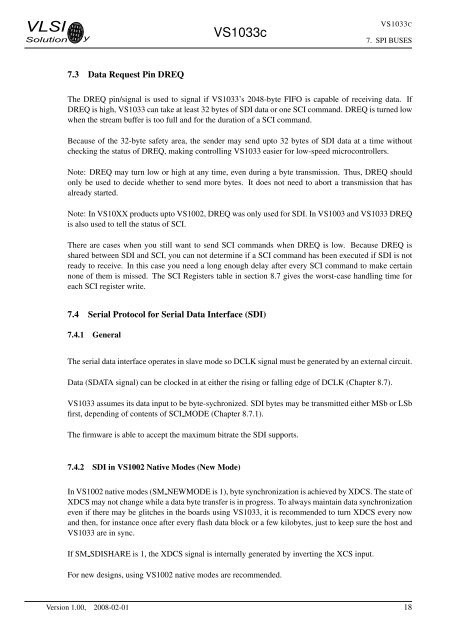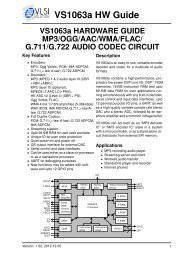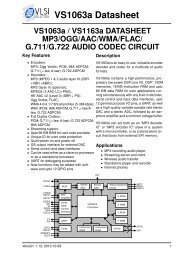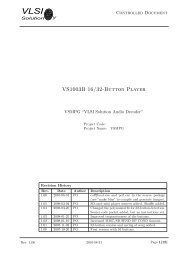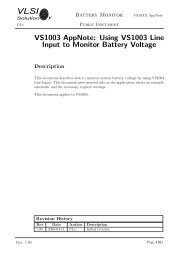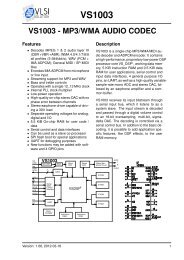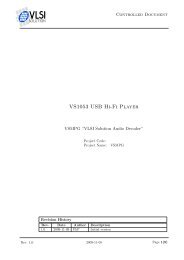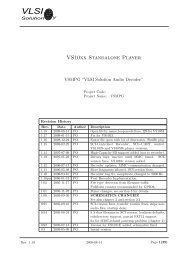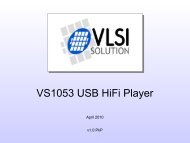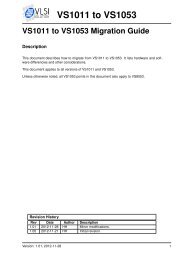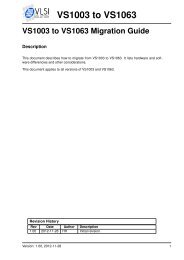VS1033 - MP3/AAC/WMA/MIDI AUDIO CODEC - VLSI Solution
VS1033 - MP3/AAC/WMA/MIDI AUDIO CODEC - VLSI Solution
VS1033 - MP3/AAC/WMA/MIDI AUDIO CODEC - VLSI Solution
Create successful ePaper yourself
Turn your PDF publications into a flip-book with our unique Google optimized e-Paper software.
<strong>VLSI</strong><strong>Solution</strong> y<strong>VS1033</strong>c<strong>VS1033</strong>C7. SPI BUSES7.3 Data Request Pin DREQThe DREQ pin/signal is used to signal if <strong>VS1033</strong>’s 2048-byte FIFO is capable of receiving data. IfDREQ is high, <strong>VS1033</strong> can take at least 32 bytes of SDI data or one SCI command. DREQ is turned lowwhen the stream buffer is too full and for the duration of a SCI command.Because of the 32-byte safety area, the sender may send upto 32 bytes of SDI data at a time withoutchecking the status of DREQ, making controlling <strong>VS1033</strong> easier for low-speed microcontrollers.Note: DREQ may turn low or high at any time, even during a byte transmission. Thus, DREQ shouldonly be used to decide whether to send more bytes. It does not need to abort a transmission that hasalready started.Note: In VS10XX products upto VS1002, DREQ was only used for SDI. In VS1003 and <strong>VS1033</strong> DREQis also used to tell the status of SCI.There are cases when you still want to send SCI commands when DREQ is low. Because DREQ isshared between SDI and SCI, you can not determine if a SCI command has been executed if SDI is notready to receive. In this case you need a long enough delay after every SCI command to make certainnone of them is missed. The SCI Registers table in section 8.7 gives the worst-case handling time foreach SCI register write.7.4 Serial Protocol for Serial Data Interface (SDI)7.4.1 GeneralThe serial data interface operates in slave mode so DCLK signal must be generated by an external circuit.Data (SDATA signal) can be clocked in at either the rising or falling edge of DCLK (Chapter 8.7).<strong>VS1033</strong> assumes its data input to be byte-sychronized. SDI bytes may be transmitted either MSb or LSbfirst, depending of contents of SCI MODE (Chapter 8.7.1).The firmware is able to accept the maximum bitrate the SDI supports.7.4.2 SDI in VS1002 Native Modes (New Mode)In VS1002 native modes (SM NEWMODE is 1), byte synchronization is achieved by XDCS. The state ofXDCS may not change while a data byte transfer is in progress. To always maintain data synchronizationeven if there may be glitches in the boards using <strong>VS1033</strong>, it is recommended to turn XDCS every nowand then, for instance once after every flash data block or a few kilobytes, just to keep sure the host and<strong>VS1033</strong> are in sync.If SM SDISHARE is 1, the XDCS signal is internally generated by inverting the XCS input.For new designs, using VS1002 native modes are recommended.Version 1.00, 2008-02-01 18


